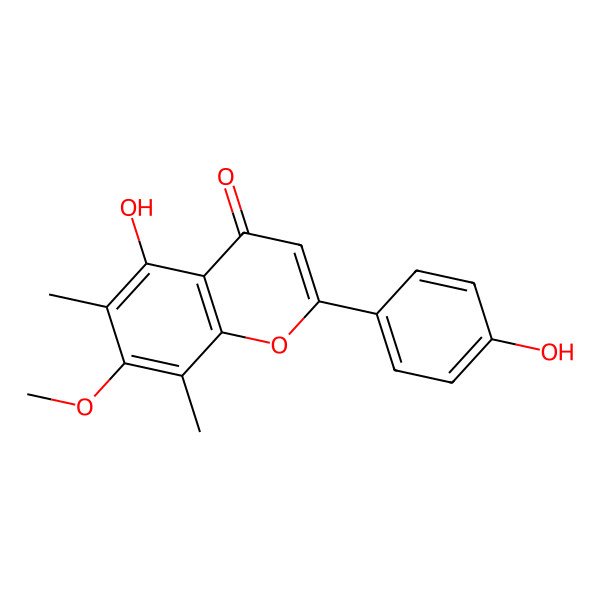Sideroxylin
| Internal ID | b006f5c4-ea30-4cdd-96d1-f1f289d742c5 |
| Taxonomy | Phenylpropanoids and polyketides > Flavonoids > O-methylated flavonoids > 7-O-methylated flavonoids |
| IUPAC Name | 5-hydroxy-2-(4-hydroxyphenyl)-7-methoxy-6,8-dimethylchromen-4-one |
| SMILES (Canonical) | CC1=C(C2=C(C(=C1OC)C)OC(=CC2=O)C3=CC=C(C=C3)O)O |
| SMILES (Isomeric) | CC1=C(C2=C(C(=C1OC)C)OC(=CC2=O)C3=CC=C(C=C3)O)O |
| InChI | InChI=1S/C18H16O5/c1-9-16(21)15-13(20)8-14(11-4-6-12(19)7-5-11)23-18(15)10(2)17(9)22-3/h4-8,19,21H,1-3H3 |
| InChI Key | QJSQOGJCHBXLAH-UHFFFAOYSA-N |
| Popularity | 16 references in papers |
| Molecular Formula | C18H16O5 |
| Molecular Weight | 312.30 g/mol |
| Exact Mass | 312.09977361 g/mol |
| Topological Polar Surface Area (TPSA) | 76.00 Ų |
| XlogP | 3.70 |
| 3122-87-0 |
| Sideroxyline |
| 4',5-Dihydroxy-7-methoxy-6,8-dimethylflavone |
| CHEBI:69916 |
| 5-hydroxy-2-(4-hydroxyphenyl)-7-methoxy-6,8-dimethylchromen-4-one |
| 4H-1-Benzopyran-4-one, 5-hydroxy-2-(4-hydroxyphenyl)-7-methoxy-6,8-dimethyl- |
| 5-Hydroxy-2-(4-hydroxyphenyl)-7-methoxy-6,8-dimethyl-4H-1-benzopyran-4-one |
| CHEMBL1819400 |
| DTXSID00185144 |
| HY-N1306 |
| There are more than 10 synonyms. If you wish to see them all click here. |

| Target | Value | Probability (raw) | Probability (%) |
|---|---|---|---|
| No predicted properties yet! | |||
Proven Targets:
| CHEMBL ID | UniProt ID | Name | Min activity | Assay type | Source |
|---|---|---|---|---|---|
| No proven targets yet! | |||||
Predicted Targets (via Super-PRED):
| CHEMBL ID | UniProt ID | Name | Probability | Model accuracy |
|---|---|---|---|---|
| CHEMBL5619 | P27695 | DNA-(apurinic or apyrimidinic site) lyase | 97.65% | 91.11% |
| CHEMBL2635 | P51452 | Dual specificity protein phosphatase 3 | 96.68% | 94.00% |
| CHEMBL2581 | P07339 | Cathepsin D | 94.66% | 98.95% |
| CHEMBL242 | Q92731 | Estrogen receptor beta | 92.39% | 98.35% |
| CHEMBL1860 | P10827 | Thyroid hormone receptor alpha | 91.84% | 99.15% |
| CHEMBL3108638 | O15164 | Transcription intermediary factor 1-alpha | 91.78% | 95.56% |
| CHEMBL1806 | P11388 | DNA topoisomerase II alpha | 91.20% | 89.00% |
| CHEMBL4261 | Q16665 | Hypoxia-inducible factor 1 alpha | 89.18% | 85.14% |
| CHEMBL1293249 | Q13887 | Kruppel-like factor 5 | 87.33% | 86.33% |
| CHEMBL2288 | Q13526 | Peptidyl-prolyl cis-trans isomerase NIMA-interacting 1 | 86.39% | 91.71% |
| CHEMBL3194 | P02766 | Transthyretin | 84.81% | 90.71% |
| CHEMBL3060 | Q9Y345 | Glycine transporter 2 | 83.54% | 99.17% |
| CHEMBL5905 | Q04828 | Aldo-keto reductase family 1 member C1 | 82.24% | 91.79% |
| CHEMBL3401 | O75469 | Pregnane X receptor | 81.94% | 94.73% |
| CHEMBL3922 | P50579 | Methionine aminopeptidase 2 | 81.39% | 97.28% |
| CHEMBL5409 | Q8TDU6 | G-protein coupled bile acid receptor 1 | 81.21% | 93.65% |
| CHEMBL3038477 | P67870 | Casein kinase II alpha/beta | 80.54% | 99.23% |
| CHEMBL5845 | P23415 | Glycine receptor subunit alpha-1 | 80.50% | 90.71% |
| CHEMBL2345 | P51812 | Ribosomal protein S6 kinase alpha 3 | 80.24% | 95.64% |
| CHEMBL4203 | Q9HAZ1 | Dual specificity protein kinase CLK4 | 80.14% | 94.45% |
Below are displayed all the plants proven (via scientific papers) to contain this
compound!
To see more specific details click the taxa you are interested in.
To see more specific details click the taxa you are interested in.
| Bombax ceiba |
| Eucalyptus globulus |
| Eucalyptus robusta |
| Eucalyptus saligna |
| Eucalyptus sideroxylon |
| Eucalyptus tereticornis |
| Hydrastis canadensis |
| Kalmia latifolia |
| Myrtus communis |
| Syzygium alternifolium |
| PubChem | 3083788 |
| NPASS | NPC159275 |
| ChEMBL | CHEMBL1819400 |
| LOTUS | LTS0152612 |
| wikiData | Q27138261 |